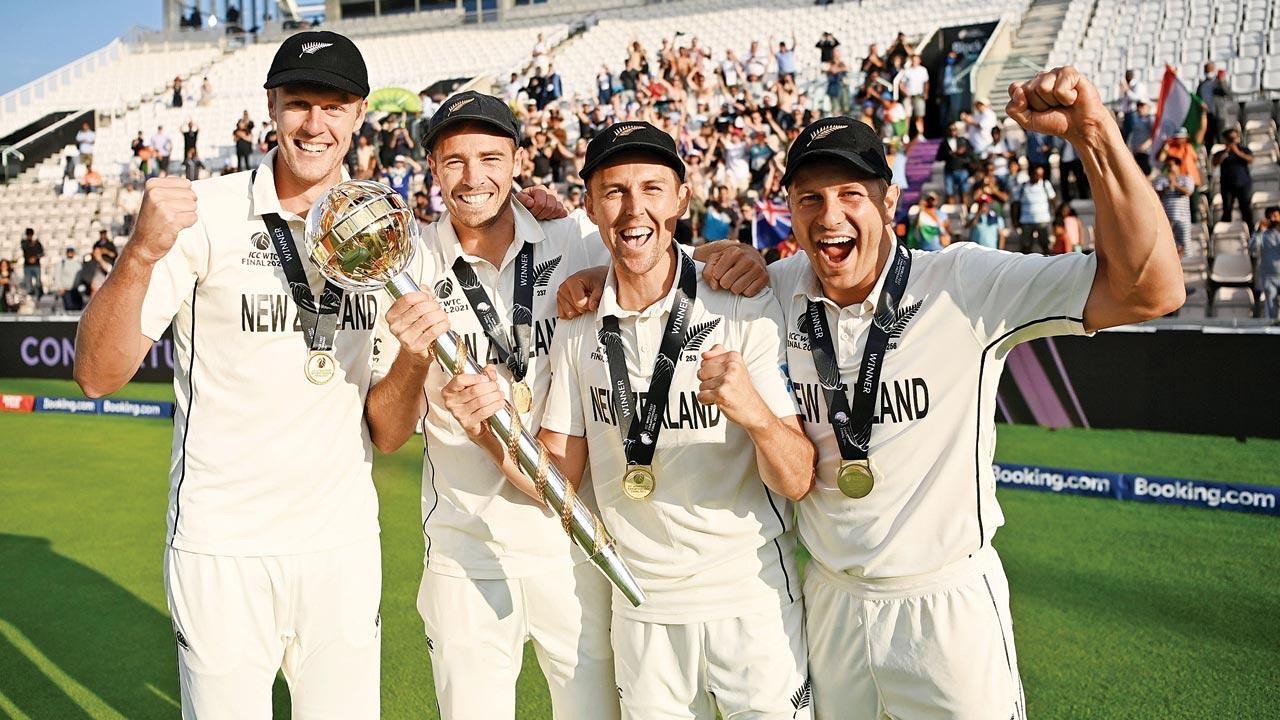While the Kiwis owe their WTC success to Tim Southee, Trent Boult, Kyle Jamieson and Neil Wagner, the West Indies’ cutting crew of Andy Roberts, Malcolm Marshall, Michael Holding and Joel Garner stood out for pace

NZ pacers Kyle Jamieson (left), Tim Southee, Trent Boult and Neil Wagner (right) celebrate winning the ICC World Test Championship final against India last month. Pics/Getty Images
New Zealand’s well-deserved win in the World Test Championship [WTC] final, highlighted an accepted adage in cricket; pace bowling rules. Their pace quartet made possible their presence in the final. Then in the prolonged battle with India for supremacy, the pace bowlers led the last day victory charge. Such was the influence of the New Zealand attack that there was even a comparison with the formidable West Indies quartets that ruled from the late 1970s to the mid-1990s.
WI quartet wins hands down
ADVERTISEMENT
To my mind, the best combination of those fearsome quartets was Andy Roberts, Malcolm Marshall, Michael Holding and Joel Garner. If it’s pace you’re talking about the West Indies quartet wins hands down. However, if you look purely at results the New Zealand four take the prize; five matches together for a 100 per cent winning record. That West Indian combination only played together in six matches and while never beaten, they were held to three draws.
West Indies pace quartet Andy Roberts (left), Michael Holding, Colin Croft and Joel Garner (right) during the first Test against England at Trinidad in 1981
New Zealand played five of their six matches at home and then the final at the Ageas Bowl, all favourable venues for swing and seam bowling. The West Indies three draws were all affected by inclement weather in an era when time lost was exactly that. The statistical leader of New Zealand’s group is undoubtedly Kyle Jamieson with 28 wickets at the uncovered-pitches-average of 12.07. However, experience wise its swing bowler Tim Southee who leads the way.
For the West Indies foursome, there was never any doubt about their leader—spiritually and on the rare occasion he spoke, verbally. It was Roberts who confidently assured his batsmen: “It doesn’t matter what the opposition bowl us out for, we’ll bowl them out for less.”
He lived up to that promise and even though he was the veteran of that foursome he stood out in the six matches, claiming 33 wickets at the miserly average of 17.48. Roberts and England’s John Snow were the two best opposition pace bowlers I faced.
Also Read: Happy days are here again!
Dennis Lillee and Jeff Thomson
There haven’t been many pace quartets as the concept was only made popular by West Indies captain Clive Lloyd after his team took a hammering from Australia’s demon pace bowling duo of Dennis Lillee and Jeff Thomson in 1975-76.
The pace quartet became standard fare for the West Indies in their period of dominance but no other team has adopted the policy to that extent. However Australia did feature a formidable pace quartet for seven matches in the mid-1950’s. Ray Lindwall, Keith Miller, Bill Johnston and Ron Archer were all genuine new ball bowlers in their own right and operated at considerable speed.
Thanks to the presence of one genuine (Miller) and three bowling all-rounders in Lindwall, Richie Benaud and Archer, the attack also included two spinners. This has to be one of the best balanced attacks of all time.
Pace bowling trios
Pace bowling trios are more prevalent and there have been quite a few successful ones. These include Pakistan’s Wasim Akram, Waqar Younis and Aaqib Javed; South Africa’s Alan Donald, Shaun Pollock and Brian McMillan. Surprisingly, England didn’t take advantage of Fred Trueman, Brian Statham and Frank Tyson’s considerable pace as they only played together in one Test.
When it comes to high-speed threesomes Lillee, Thomson and Len Pascoe played four Super Tests together during World Series Cricket in 1979; that would’ve had a speed gun whirring.
Spin bowling has been more a case of working in pairs. There have been some mighty successful ones but India did break the mould for a decade with a highly successful spin trio in Erapalli Prasanna, Bishan Bedi and Bhagwat Chandrasekhar.
While a success rate of just below 30% doesn’t fully reflect that trio’s ability, it does hint at the advantage of the intimidation factor pace bowling provides.
Indians join the ranks
In recent years, India have joined the ranks of pace bowling proficient teams. As a consequence they’ve enjoyed success in Australia, reached the final of the WTC and now have an even money chance of beating England on their home turf.
Good pace bowling definitely has its advantages.
Also Read: Euro 2020: Harry Kane brace leads England past Ukraine and into semis
 Subscribe today by clicking the link and stay updated with the latest news!" Click here!
Subscribe today by clicking the link and stay updated with the latest news!" Click here!







